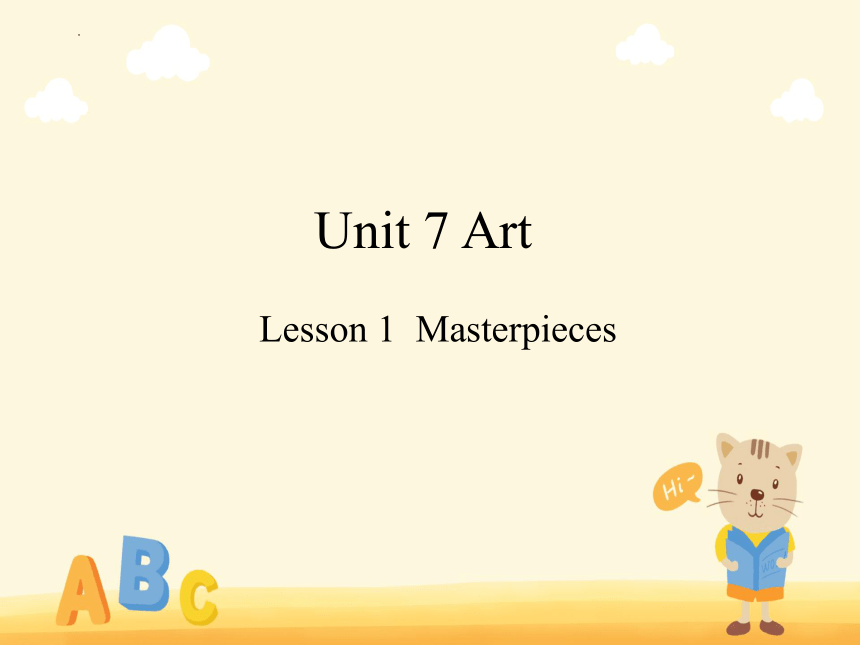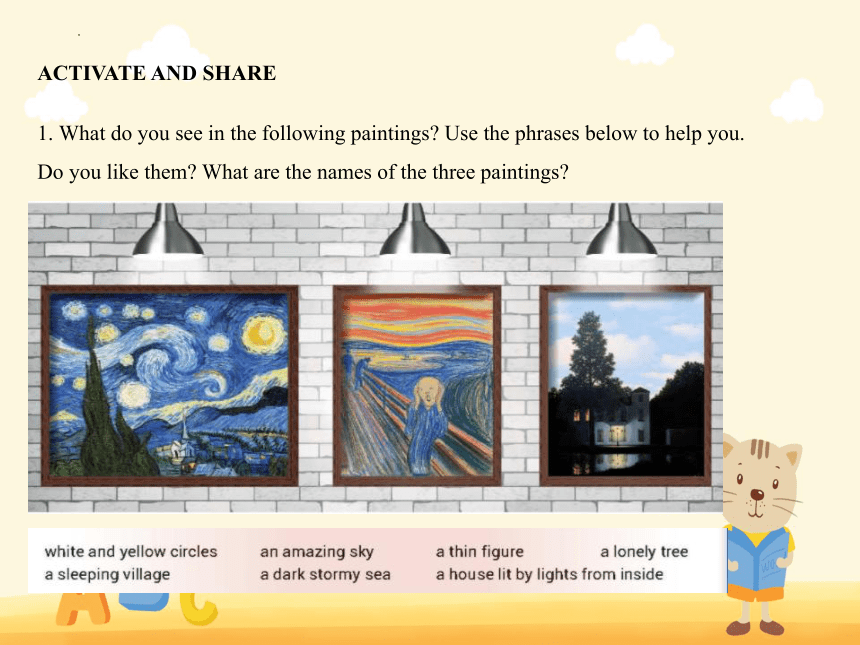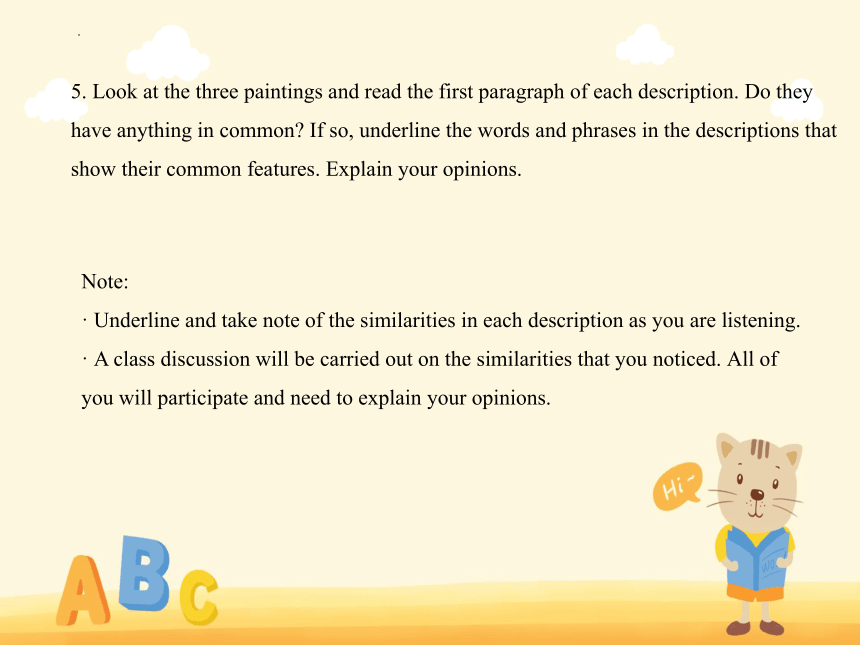北师大版(2019) 必修第三册 Unit 7 Art Lesson 1 Masterpieces Lesson 1 Masterpieces 课件(14张ppt)
文档属性
| 名称 | 北师大版(2019) 必修第三册 Unit 7 Art Lesson 1 Masterpieces Lesson 1 Masterpieces 课件(14张ppt) |

|
|
| 格式 | pptx | ||
| 文件大小 | 1.9MB | ||
| 资源类型 | 教案 | ||
| 版本资源 | 北师大版(2019) | ||
| 科目 | 英语 | ||
| 更新时间 | 2022-10-22 13:02:59 | ||
图片预览







文档简介
(共14张PPT)
Unit 7 Art
Lesson 1 Masterpieces
1. What do you see in the following paintings Use the phrases below to help you.
Do you like them What are the names of the three paintings
ACTIVATE AND SHARE
2. Read the descriptions of the three paintings.Underline the name of each painting and its artist.Find out what each painting is about.
READ AND EXPLORE
3. Read the three descriptions again. Use the diagram below to help you take notes. Then talk about each painting.
4. Pair Work Sort the expressions into the correct columns. Use them to practise introducing the paintings.
5. Look at the three paintings and read the first paragraph of each description. Do they have anything in common If so, underline the words and phrases in the descriptions that show their common features. Explain your opinions.
Note:
· Underline and take note of the similarities in each description as you are listening.
· A class discussion will be carried out on the similarities that you noticed. All of you will participate and need to explain your opinions.
6. What's your opinion of the three paintings after reading the descriptions Do you like or dislike them more Give your reasons.
Note:
· Write a few sentences on each painting, expressing their opinion.
· Use the following vocabulary words: artistic beauty, originality, emotional, atmosphere, colour scheme, dramatic, highlights, the painting makes me feel uneasy/inspired, dark and troubling, failure, powerful.
7. Group Work Suppose you are a volunteer at an art exhibition. Introduce one of the three paintings to the visitors.
Note:
· The class will be divided into small groups.
· Each group chooses one painting and selects one person to be the scribe and write down notes for the group.
· Everyone in the group describes the painting, and provides background to the painting, the artist, the inspiration behind the painting, etc. The scribe can mind map this information.
· Each group writes at least ten complete sentences about the painting using these descriptions.
· The class can ask questions about the painting and members from the group can help to answer the questions.
8. Pair Work Read the sentences. Answer the questions.
1) Van Gogh painted what he saw from his window.
2) What makes it striking is that it shows a thin figure with an expression of fear.
3) What is strange is that above the house and the tree, we see a daytime sky full of brightness and soft white clouds.
4) Some feel that the paintings look dark and troubling.
FOCUS ON LANGUAGE: NOUN CLAUSES
Which sentence is an example of:
a a subject clause, or a noun clause that acts as the subject of the sentence
b an object clause, or a noun clause that acts as the object of the sentence
c a predicative clause, or a noun clause that acts as the predicative of the sentence
9. Combine the two expressions using a subject clause, an object clause or a predicative clause. Then write a complete sentence.
1) Magritte painted in this way
The reason was that he wanted to challenge how people see the world
2) Looking at the painting, we don't know
It is night or day
3) The fact remains
Munch's The Scream is one of the best-known paintings ever made
4) It is unclear
Van Gogh wanted to paint yellow spots or that was what he really saw
Example: It is hard to believe
Van Gogh only sold one painting during his lifetime
It is hard to believe that Van Gogh only sold one painting during his lifetime.
10. Rewrite the underlined sentences in the following paragraph using noun clauses.
See page 11 in the book.
Note:
· Read the rubric and the passage aloud. Discuss any difficult words and terminology.
· Answer questions: What type of art did he create What inspired his art What is he famous for
· Join the two independent sentences for each number, using noun clauses. The sentences need to make sense and be a complete thought.
11. Group Work Read the quotes. Discuss the features of good paintings.
EXPRESS YOURSELF
A man paints with his brain and not with his hands.
-Michelangelo, an Italian painter
Painting is silent poetry and poetry is painting that speaks.
-Plutarch, an ancient Greek writer
Good painting is like good cooking; it can be tasted but not explained.
-Maurice de Vlaminck, a French painter
THANK YOU
Unit 7 Art
Lesson 1 Masterpieces
1. What do you see in the following paintings Use the phrases below to help you.
Do you like them What are the names of the three paintings
ACTIVATE AND SHARE
2. Read the descriptions of the three paintings.Underline the name of each painting and its artist.Find out what each painting is about.
READ AND EXPLORE
3. Read the three descriptions again. Use the diagram below to help you take notes. Then talk about each painting.
4. Pair Work Sort the expressions into the correct columns. Use them to practise introducing the paintings.
5. Look at the three paintings and read the first paragraph of each description. Do they have anything in common If so, underline the words and phrases in the descriptions that show their common features. Explain your opinions.
Note:
· Underline and take note of the similarities in each description as you are listening.
· A class discussion will be carried out on the similarities that you noticed. All of you will participate and need to explain your opinions.
6. What's your opinion of the three paintings after reading the descriptions Do you like or dislike them more Give your reasons.
Note:
· Write a few sentences on each painting, expressing their opinion.
· Use the following vocabulary words: artistic beauty, originality, emotional, atmosphere, colour scheme, dramatic, highlights, the painting makes me feel uneasy/inspired, dark and troubling, failure, powerful.
7. Group Work Suppose you are a volunteer at an art exhibition. Introduce one of the three paintings to the visitors.
Note:
· The class will be divided into small groups.
· Each group chooses one painting and selects one person to be the scribe and write down notes for the group.
· Everyone in the group describes the painting, and provides background to the painting, the artist, the inspiration behind the painting, etc. The scribe can mind map this information.
· Each group writes at least ten complete sentences about the painting using these descriptions.
· The class can ask questions about the painting and members from the group can help to answer the questions.
8. Pair Work Read the sentences. Answer the questions.
1) Van Gogh painted what he saw from his window.
2) What makes it striking is that it shows a thin figure with an expression of fear.
3) What is strange is that above the house and the tree, we see a daytime sky full of brightness and soft white clouds.
4) Some feel that the paintings look dark and troubling.
FOCUS ON LANGUAGE: NOUN CLAUSES
Which sentence is an example of:
a a subject clause, or a noun clause that acts as the subject of the sentence
b an object clause, or a noun clause that acts as the object of the sentence
c a predicative clause, or a noun clause that acts as the predicative of the sentence
9. Combine the two expressions using a subject clause, an object clause or a predicative clause. Then write a complete sentence.
1) Magritte painted in this way
The reason was that he wanted to challenge how people see the world
2) Looking at the painting, we don't know
It is night or day
3) The fact remains
Munch's The Scream is one of the best-known paintings ever made
4) It is unclear
Van Gogh wanted to paint yellow spots or that was what he really saw
Example: It is hard to believe
Van Gogh only sold one painting during his lifetime
It is hard to believe that Van Gogh only sold one painting during his lifetime.
10. Rewrite the underlined sentences in the following paragraph using noun clauses.
See page 11 in the book.
Note:
· Read the rubric and the passage aloud. Discuss any difficult words and terminology.
· Answer questions: What type of art did he create What inspired his art What is he famous for
· Join the two independent sentences for each number, using noun clauses. The sentences need to make sense and be a complete thought.
11. Group Work Read the quotes. Discuss the features of good paintings.
EXPRESS YOURSELF
A man paints with his brain and not with his hands.
-Michelangelo, an Italian painter
Painting is silent poetry and poetry is painting that speaks.
-Plutarch, an ancient Greek writer
Good painting is like good cooking; it can be tasted but not explained.
-Maurice de Vlaminck, a French painter
THANK YOU
同课章节目录
- Unit 7 Art
- Lesson 1 Masterpieces
- Lesson 2 Beijing Opera
- Lesson 3 A Musical Genius
- Unit 8 Green living
- Lesson 1 Roots and Shoots
- Lesson 2 Greening the Desert
- Lesson 3 "White Bikes" on the Road
- Unit 9 Learning
- Lesson 1 Active Learning
- Lesson 2 Language Learning Tips
- Lesson 3 The Secrets of Your Memory
